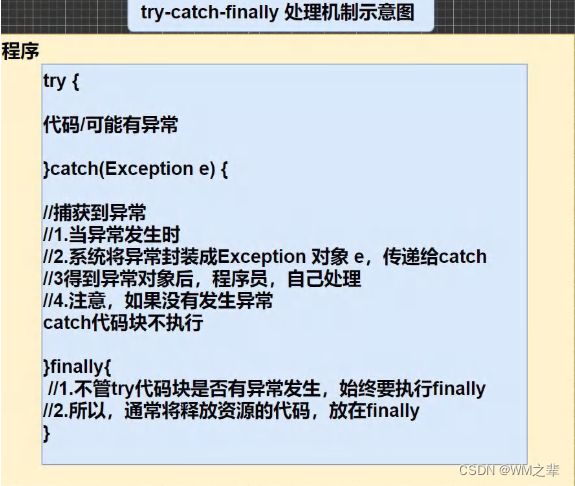Java中异常的详细讲解与细节讨论
用一个代码引出异常为什么要使用异常
代码:
public static void main(Sting args[]){
int n1 = 1;
int n2 = 0;
System.out.println(n1/n2);//这里会抛ArihmaticException,因为除数不能为0,若未用异常处理机制则程序直接结束,后面的代码将不执行。这样很不好,我们不能因为一个非致命的错误而结束整个程序
.
.
.
}异常的基本介绍:
在Java中,异常是指在程序执行过程中发生的错误或异常情况。Java中的异常处理机制允许我们捕获和处理这些异常,以便程序能够继续执行或进行适当的处理。
异常分为两类:
(1)编译时异常,是编译器要求解决的异常,必须解决,否则程序跑不起来。如:ClassNotFounfException(找不到类异常)...
(2)运行时异常,编译器检查不出来,一般是指编程时的逻辑错误,程序员应当避免。如:NullPointerException(空指针异常),ArithmeticException(数学运算异常),ArrayIndexOutOfBoundsException(数组下标越界异常),ClassCastException(类型转换异常),NumberFormatException(数字格式不正确异常)...
NullPointerException(空指针异常)代码:
public class NullPointException {
public static void main(String[] args) {
//当应用程序试图在需要对象的地方使用null时,抛出该异常
String name1 = null;
String name2 = "";
try {
System.out.println(name1.length());//空指针
} catch (Exception e) {
e.printStackTrace();
}
System.out.println(name2.length());
}
}ArithmeticException(数学运算异常)代码:
public class ArithmeticException {
public static void main(String[] args) {
//当出现异常的运算条件时,抛出此异常
int n1 = 1;
int n2 = 0;
try {
System.out.println(n1/n2);//除数不能为0
} catch (Exception e) {
// e.printStackTrace();
System.out.println(e.getMessage());
}
}
}ArrayIndexOutOfBoundsException(数组下标越界异常)代码:
public class ArrayIndexOutOfBoundsException {
public static void main(String[] args) {
//用非法索引访问数组时抛出的异常
int[] array = {1,2,3};
for (int i = 0; i <= array.length; i++) {
System.out.println(array[i]);//数组越界了,。没有array[3]
}
}
}ClassCastException(类型转换异常)代码:
public class ClassCastException {
public static void main(String[] args) {
A b = new B();//向上转型
B b2 = (B)b;//向下转型
//当试图将对象强制转换为不是实例的子类时,抛出该异常
C c = (C) b;//这里会抛出ClassCastException,因为B类和C类没有关系,并不能类型转换
}
}
class A{}
class B extends A{}
class C extends A{}NumberFormatException(数字格式不正确异常)代码:
public class NumberFormatException {
public static void main(String[] args) {
String name2 = "123";
int n2 = Integer.parseInt(name2);
System.out.println(n2);
//当应用程序试图将字符串转换成一种数值类型,但该字符串不能转换为适当格式时,抛出该异常
//当要把字符串转换为数字时,但是该字符串不能转换为数字时抛出的异常
String name1 = "ret";
int n1 = Integer.parseInt(name1);//这里会抛出NumberFormatException,因为ret不能转换为数字
System.out.println(n1);
}
}异常处理方式:
(1)try-catch-finally,程序员在代码中捕获发生的异常,自行处理。(就地解决)
(2)throws,将发生的异常抛出,交给调用者(方法)来处理,最顶级的处理者是JVM,而JVM的处理就是直接报错,结束程序
try-catch-finally处理机制示意图:
throws处理机制示意图:
try-catch-finally细节讨论:
(1)如果try块中的异常发生了,则异常发生后面的代码不会执行,直接进入到 catch 块
(2)如果异常没有发生,则顺序执行 try 的代码块,不会进入到 catch块中
(3)如果希望不管是否发生异常,都执行某段代码(比如关闭连接,释放资源等)则将代码放在finally块中
代码:
public static void main(String args[]){
try {
String str = "ret";
int a = Integer.parseInt(str);
System.out.println("数字:" + a);
} catch (Exception e) {
System.out.println("异常信息=" + e.getMessage());
} finally {
System.out.println("finally的代码块被执行");
}
System.out.println("程序继续...");
}
/*
输出结果:
异常信息=For input string: "ret"
finally的代码块被执行
程序继续...
*/(4)可以有多个catch语句,捕获不同的异常(进行不同的业务处理),要求父类异常在后,子类异常在前
代码:
public class TryCatchFinallyDetails {
public static void main(String[] args) {
//1.如果 try 代码块有可能有多个异常
//2.可以使用多个 catch 分别捕获不同的异常,相应处理
//3.要求子类异常写在前面,父类异常写在后面
try {
People people = new People();
System.out.println(people.getName());//NullPointerException
int n1 = 10;
int n2 = 0;
int res = n1 / n2;//ArithmeticException
} catch (NullPointerException e) {
System.out.println("空指针异常=" + e.getMessage());
} catch (ArithmeticException e) {
System.out.println("算术异常=" + e.getMessage());
} catch (Exception e) {//Exception是ArithmeticException和NullPointerException的父类
System.out.println(e.getMessage());
} finally {
System.out.println("执行finally语句");
}
}
}
class People {
private String name = "ret";
public String getName() {
return name;
}
}
/*
输出结果:
ret
算术异常=/ by zero
执行finally语句
*/(5)可以进行 try-finally 配合使用, 这种用法相当于没有捕获异常,因此程序会直接崩掉/退出。应用场景,就是执行一段代码,不管是否发生异常,都必须执行某个业务逻辑
代码:
public static void main(String[] args) {
/*
可以进行 try-finally 配合使用, 这种用法相当于没有捕获异常,
因此程序会直接崩掉/退出。应用场景,就是执行一段代码,不管是否发生异常,
都必须执行某个业务逻辑
*/
try {
int n1 = 10;
int n2 = 0;
System.out.println(n1 / n2);
} finally {
System.out.println("执行了 finally..");
}
System.out.println("程序继续执行..");
}throws细节讨论:
(1)对于运行时异常,程序中如果没有处理,默认就是throws的方式处理
(2)子类重写父类的方法时,对抛出异常的规定:子类重写的方法,所抛出的异常类型要么和父类抛出的异常一致,要么抛出的异常类型是父类抛出异常的子类型
(3)在throws过程中,如果有try_catch,就相当于处理异常了,就不必throws了
代码:
package com.example.retcode.test.exception.throws_;
import java.io.FileInputStream;
import java.io.FileNotFoundException;
/**
* @author ruientao
* @version 1.0
* 2023/8/21 21:11
* @description TODO
*/
public class ThrowsDetails {
public static void main(String[] args) {
f2();
}
public static void f2() /*没有进行try_catch处理异常,就默认了throws,而且是throws ArithmeticException*/ {
//1.对于编译异常,程序中必须处理,比如try-catch或者throws
//2.对于运行时异常,程序中如果没有处理,默认就是throws的方式处理
int n1 = 10;
int n2 = 0;
double res = n1 / n2;
}
public static void f1() throws FileNotFoundException {
//调用f3()会报错
//1. 因为 f3() 方法抛出的是一个编译异常,即这时,就要 f1() 必须处理这个编译异常,在f1()中,要么try-catch-finally,或者继续throws这个编译异常
f3(); // 抛出异常
}
public static void f3() throws FileNotFoundException {
FileInputStream fis = new FileInputStream("d://java.txt");
}
public static void f4() {
//在 f4()中调用方法f5()是可以的,原因是f5()抛出的是运行异常
//在java中,并不要求程序员显示处理,因为有默认处理机制
f5();
}
public static void f5() throws ArithmeticException {
}
}
class Father { //父类
public void method() throws RuntimeException {
}
}
class Son extends Father {//子类
//子类重写父类的方法时,对抛出异常的规定:子类重写的方法,所抛出的异常类型要么和父类抛出的异常一致,要么为父类抛出的异常类型的子类型
//在throws过程中,如果有方法try-catch,就相当于处理异常,就可以不必throws
@Override
public void method() throws ArithmeticException {
}
}
自定义异常:
当程序中出现了某种错误,但是错误信息并没有在Throwable子类中描述处理,这个时候可以自己设计异常类,用于描述该错误信息
细节讨论:
(1)自定义异常类名(程序员自己定),继承Exception或RuntimeException
(2)如果继承Exception,属于编译异常,如果继承RuntimeException,属于运行异常(一般来说继承RuntimeException,好处时,我们可以使用默认的处理机制,比较方便)
代码:
public class CustomException {
public static void main(String[] args) /*throws AgeException*/ {
int age = 158;
//要求范围在 18 – 120 之间,否则抛出一个自定义异常
if (!(age >= 18 && age <= 120)) {
//这里我们可以通过构造器,设置信息
try {
throw new AgeException("年龄需要在 18~120 之间");
} catch (AgeException e) {
System.out.println(e.getMessage());
}
} else {
System.out.println("你的年龄范围正确:" + age + "岁");
}
}
}
class AgeException extends RuntimeException {
public AgeException(String message) {//构造器
super(message);
}
}throw 和 throws 的区别:


